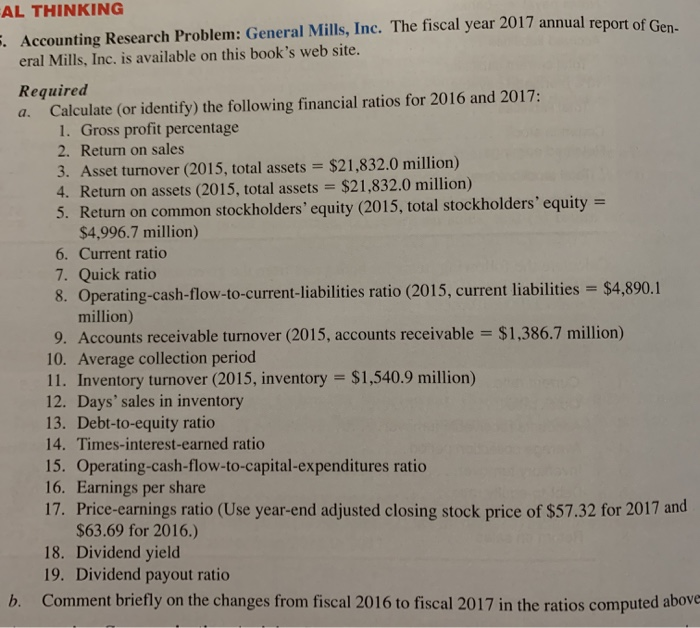AL THINKING 5. Accounting Research Problem: General Mills, Inc. The fiscal year 2017 annual report of eral Mills, Inc. is available on this book's web site. Required a. Calculate (or identify) the following financial ratios for 2016 and 2017: 1. Gross profit percentage 2. Return on sales 3. Asset turnover (2015, total assets = $21,832.0 million) 4. Return on assets (2015, total assets = $21,832.0 million) 5. Return on common stockholders' equity (2015, total stockholders' equity = $4,996.7 million) 6. Current ratio 7. Quick ratio 8. Operating-cash-flow-to-current liabilities ratio (2015, current liabilities = $4,890.1 million) 9. Accounts receivable turnover (2015, accounts receivable = $1,386.7 million) 10. Average collection period 11. Inventory turnover (2015, inventory = $1,540.9 million) 12. Days' sales in inventory 13. Debt-to-equity ratio 14. Times-interest-earned ratio 15. Operating-cash-flow-to-capital-expenditures ratio 16. Earnings per share 17. Price-earnings ratio (Use year-end adjusted closing stock price of $57.32 for 2017 and $63.69 for 2016.) 18. Dividend yield 19. Dividend payout ratio b. Comment briefly on the changes from fiscal 2016 to fiscal 2017 in the ratios computed above AL THINKING 5. Accounting Research Problem: General Mills, Inc. The fiscal year 2017 annual report of eral Mills, Inc. is available on this book's web site. Required a. Calculate (or identify) the following financial ratios for 2016 and 2017: 1. Gross profit percentage 2. Return on sales 3. Asset turnover (2015, total assets = $21,832.0 million) 4. Return on assets (2015, total assets = $21,832.0 million) 5. Return on common stockholders' equity (2015, total stockholders' equity = $4,996.7 million) 6. Current ratio 7. Quick ratio 8. Operating-cash-flow-to-current liabilities ratio (2015, current liabilities = $4,890.1 million) 9. Accounts receivable turnover (2015, accounts receivable = $1,386.7 million) 10. Average collection period 11. Inventory turnover (2015, inventory = $1,540.9 million) 12. Days' sales in inventory 13. Debt-to-equity ratio 14. Times-interest-earned ratio 15. Operating-cash-flow-to-capital-expenditures ratio 16. Earnings per share 17. Price-earnings ratio (Use year-end adjusted closing stock price of $57.32 for 2017 and $63.69 for 2016.) 18. Dividend yield 19. Dividend payout ratio b. Comment briefly on the changes from fiscal 2016 to fiscal 2017 in the ratios computed above







